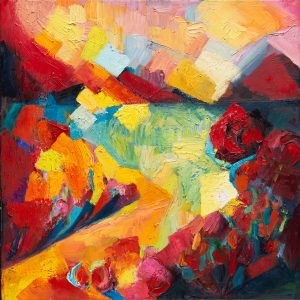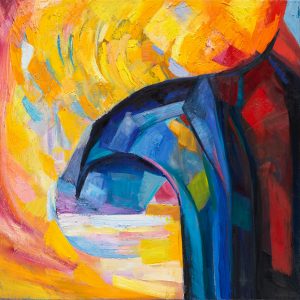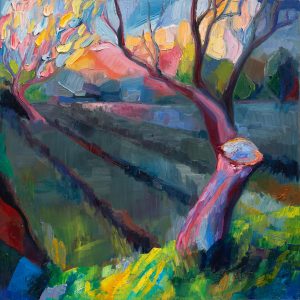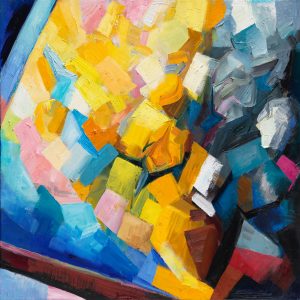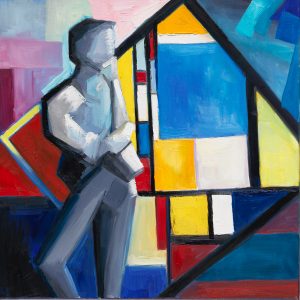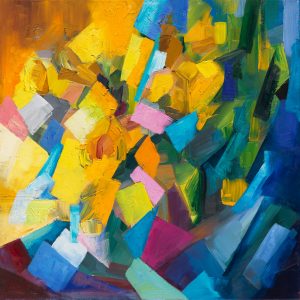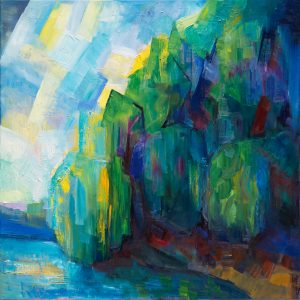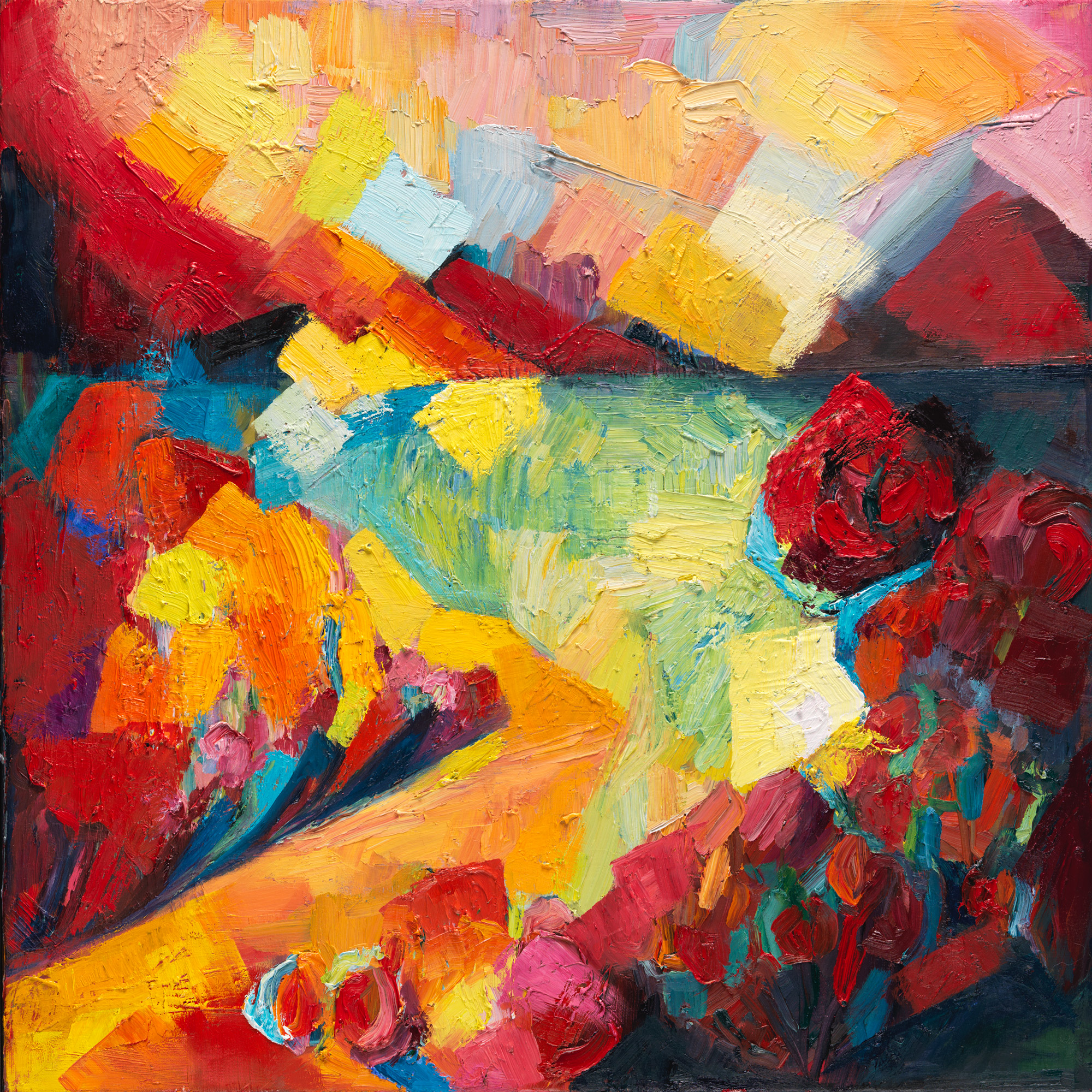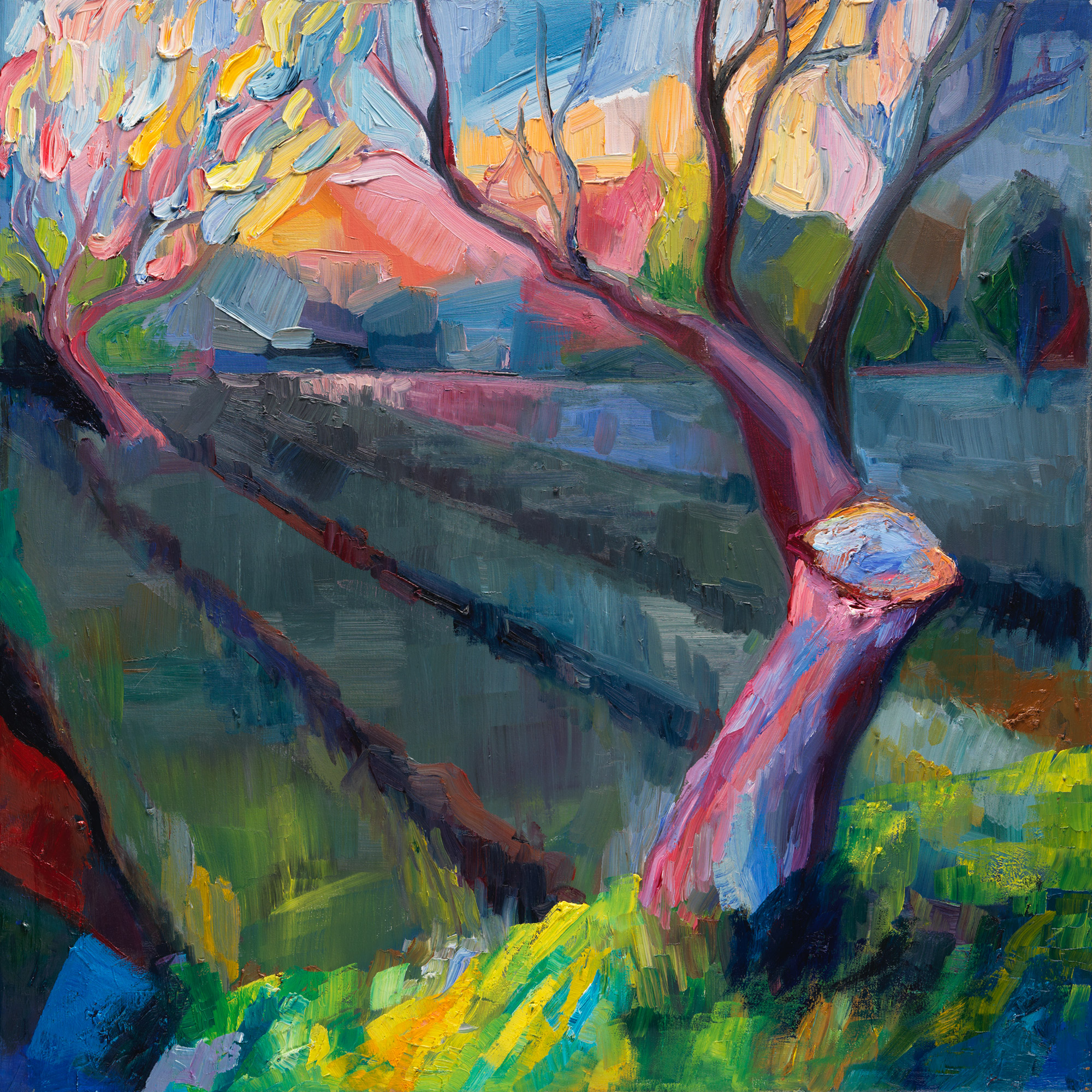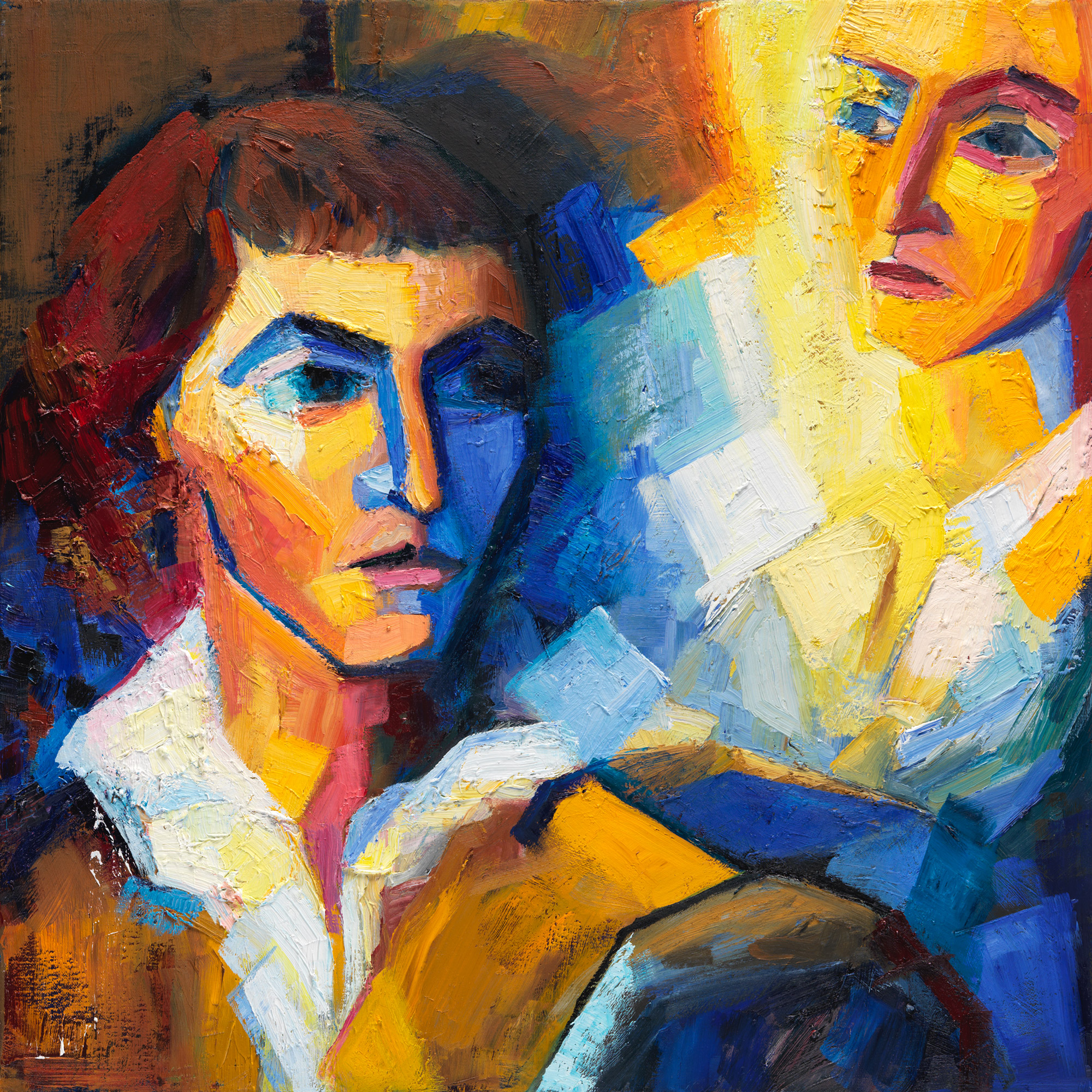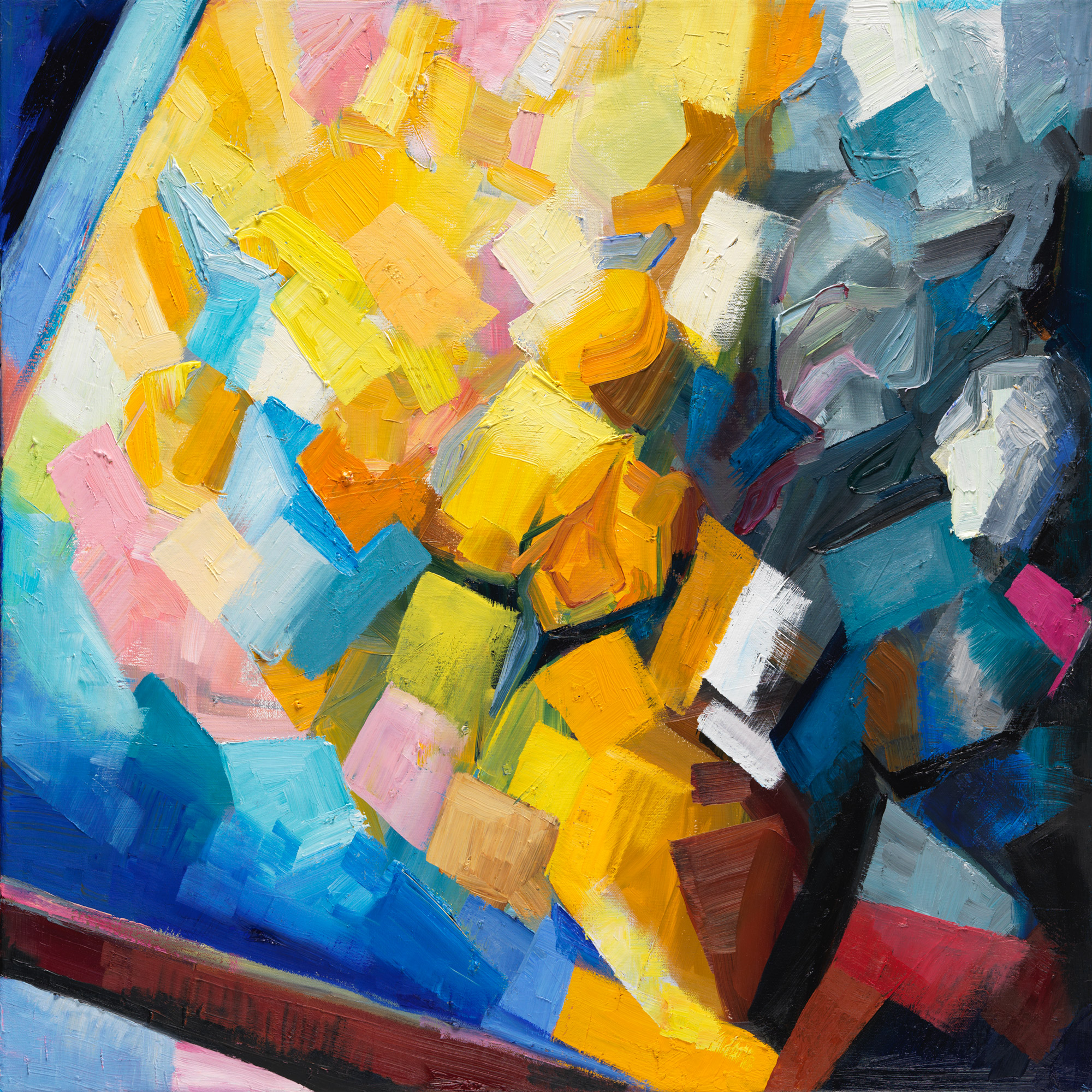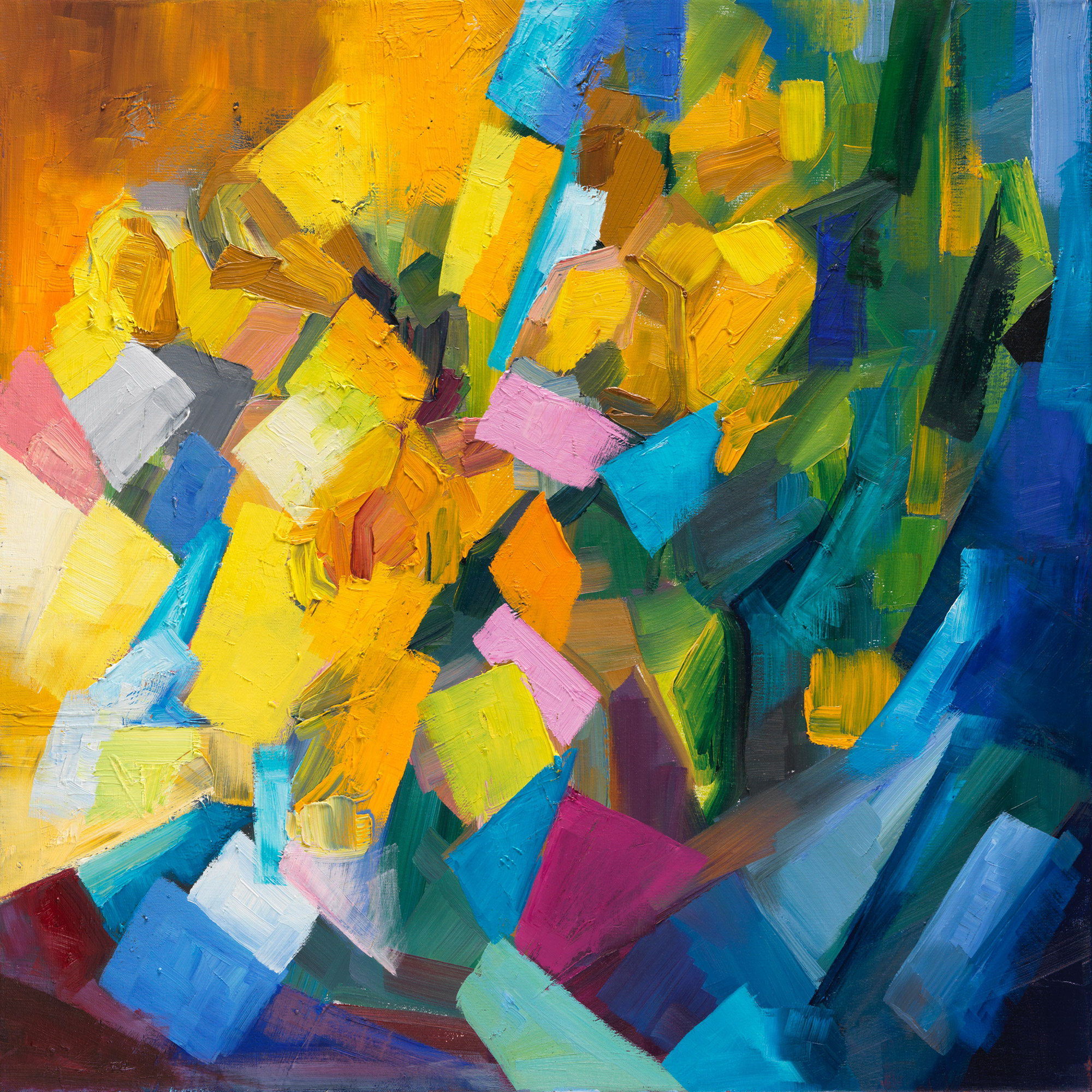Sonnets in Colour: Paradox of Self
Sonnets 1 - 9
Paradox of Self
Shakespearean
conversations
Sonnet 1. Thyself thy foe
From fairest creatures we desire increase,
That thereby beauty's rose might never die,
But as the riper should by time decease,
His tender heir might bear his memory:
But thou, contracted to thine own bright eyes,
Feed'st thy light's flame with self-substantial fuel,
Making a famine where abundance lies,
Thyself thy foe, to thy sweet self too cruel.
Thou that art now the world's fresh ornament
And only herald to the gaudy spring,
Within thine own bud buriest thy content
And, tender churl, mak'st waste in niggarding.
Pity the world, or else this glutton be,
To eat the world's due, by the grave and thee.
Conversation: introductory remarks
(March 29, 2020)
Shakespeare sonnets and paradoxes of human condition
Main points and emerging themes
As the sonnets are read traditionally, the first “act” of this drama comprises sonnets 1-17, all futile attempts to convince a young man to marry and have children. (And then, starting with sonnet 18, the whole theme of procreation is forgotten, for the sake of romantic love).
While the theme of procreation is (obviously) present in the sonnets, Shakespeare’s multidimensional analogies and metaphors expand it into a broader exploration of the paradoxical nature of human “self” in its relationship to the whole, to the world: In its pursuit of happiness and comfort, the wilful egoic self closes itself off from the flow of life, and — in doing so, incurs the curse of mortality. It is only in giving oneself to the whole that one can transcend death and become immortal.
In its pursuit of happiness and comfort, the wilful egoic self closes itself off from the flow of life, and — in doing so, incurs the curse of mortality. It is only in giving oneself to the whole that one can transcend death and become immortal.
In the structure that emerged in the process of painting the sonnets — or rather, of sonnets reinventing themselves as paintings — the opening sequence consists of two nine-sonnet “collages”, or chapters: “Paradox of Self” (1-9) and “Paradox of Death” (10-18). Thus, the sequence is bookended by two sonnets:
- Sonnet 1, which introduces main themes, metaphors, and images of the whole sequence, and especially the theme of separate Self as its own foe, and
- Sonnet 18 — probably the most famous love poem in the English literature (“Shall I compare thee to a summer’s day”).
Quite remarkably — for poems written four centuries ago — Shakespeare never thinks of immortality as any kind of eternal after-life. The only attainable immortality is here, on this earth — and its “secret” lies in participation in the flow of life through procreation — but also in immortalising power of Art (the closest one can get to eternity in Shakespeare’s universe).
But Art itself cannot participate in the flow of life without its spectators and its listeners — it cannot live without us, nor can it help us without our participation. This is the context of our conversations.
In this introductory conversation, we began to explore how the theme of this first sonnet resonate in our own lives and at this remarkable point in time...
It is often easier to believe that there is no hope, because then, what can we do? But if there is hope, then it is up to us: if the future of the world depends on us, this requires courage...
Sonnet 2. To be new made when thou art old
When forty winters shall besiege thy brow,
And dig deep trenches in thy beauty's field,
Thy youth's proud livery, so gazed on now,
Will be a tatter'd weed, of small worth held:
Then being ask'd where all thy beauty lies,
Where all the treasure of thy lusty days,
To say, within thine own deep-sunken eyes,
Were an all-eating shame and thriftless praise.
How much more praise deserved thy beauty's use,
If thou couldst answer 'This fair child of mine
Shall sum my count and make my old excuse,'
Proving his beauty by succession thine!
This were to be new made when thou art old,
And see thy blood warm when thou feel'st it cold.
Conversation: introductory remarks
(April 5, 2020)
How Shakespeare fused with van Gogh...
Main points and emerging themes
Our “normal” relationship with language is to just “get to the point”, to what is actually being said (or what we think is being said) — to collapse all metaphors, all imagery into a simple proposition, plain, straightforward argument. If we approach this sonnet like this, this is, more or less, the interpretation we get:
“When you are forty years old, all wrinkled and with deep-sunken eyes, nobody will look at you anymore, let alone adore you like now. And if they look at you at all, they will ask you, where is all thy beauty.
But wouldn’t it be nice if you could show off your (as yet not born) son, and say that this is actually your beauty…”
But this is not how the sonnet longs to be read.
Instead, it invites us to live and experience its metaphors, to swim in the semantic and acoustic waves and currents these words create... What if we allow these words to mean what they mean, to play their unique melody on the musical instrument of language living within us?
In the first stanza, then — it’s not just “forty years of age”, it is forty winters, surrounding and laying siege, like forty enemy armies, on the fortress of your Self…
... their war machines digging deep trenches in the field of beauty surrounding this fortress… And all is lost — and the cherished flowers are turned to tattered weed… And one wonders, momentarily: were these war machines or agricultural machines raping the Earth? When we read it like this, this stanza creates a sense of identity between thou (= the reader of the sonnet), and the earth itself — her fields, her trees, her flowers.
When we read it like this, this stanza creates a sense of identity between thou (= the reader of the sonnet), and the earth itself — her fields, her trees, her flowers.
And it is from the space of this identity that van Gogh’s paintings entered into my personal connection with this sonnet, to participate in the emergence of my painting translation — an old, dying, naked tree in the foreground, and a another, in the distance, whose blooming branches share their colour with the sky, and dissolve into it.
(In the video, this inner connection with van Gogh is shown line-by-line, moment-to-moment.)
Evolutionary fork
This sonnet doesn't speak of self “as a whole” (as the first one), but focuses on a particular quality, an ideal, with which a person may identify itself and their worth: beauty (as an attribute of youth) — and it puts this quality in the context of fading and renewal.
The next two stanzas invite us to experience two alternative futures:
In one future, beauty is localised, constrained, limited to the self and therefore transient.
In the other it spills into space and time, expands — so that the past and the future meet in the present… the old and the new are not in contradiction to one another anymore.
To be new made when thou art old
— when we come to these words after this journey through the poem, having lived and experienced the flow of its imagery and its metaphors, and this evolutionary fork, what do these words now mean?
The potential of this question is much broader, much more expansive than the renewal we experience through our children and grandchildren..
What comes to my mind here is the dream of butterfly — the miraculous transfiguration of a caterpillar, a completely new creature emerging from the old.
This metaphor offers one possible interpretation, one way to understand what’s going on with us now, at this point of our evolution: humanity undergoing a radical mutation, a new humanity, a butterfly-humanity, being birthed through us, in us, as us…
What does it mean for you: to be new made when thou art old?
Sonnet 3. Thy Golden Time
Look in thy glass, and tell the face thou viewest
Now is the time that face should form another;
Whose fresh repair if now thou not renewest,
Thou dost beguile the world, unbless some mother,
For where is she so fair whose unear'd womb
Disdains the tillage of thy husbandry?
Or who is he so fond will be the tomb
Of his self-love, to stop posterity?
Thou art thy mother's glass, and she in thee
Calls back the lovely April of her prime:
So thou through windows of thine age shall see
Despite of wrinkles this thy golden time.
But if thou live remember'd not to be
Die single, and thine image dies with thee.
Conversation: introductory remarks
(April 19, 2020)
Yin and Yang,
Life and Death
Main points and emergent themes
In most other Shakespearean sonnets, there is at least one “key word”, which runs through the body of the sonnet and re-appears in the couplet (that is, the last two lines). And often, this word is really the key that “unlocks” the sonnet.
But here, in Sonnet 3, there are no lexical ties between the sonnet and its couplet, but this very absence might be the key to it its meaning and to its inner music.
The transition to the couplet is abrupt, not only lexically (= no shared words), but also rhythmically — as though a smooth flow of life is interrupted, suddenly and violently.
The transition as abrupt as death itself is so often perceived to be.
As though the whole sonnet is this one single beat: live/die.
But if we look closer at the body of the sonnet, this fundamental semantic binary occurs again and again, at different scales as it were, present in every quatrain, almost in every line (and perhaps most conspicuously, in the womb/tomb rhyme in the second stanza).
Just like in life:
We live, and then we die.
But this primordial binary is not just the general “outline” of a human life, flowing from moment to moment until it ends abruptly in death. It is also the essence of its every moment, every heartbeat: live/die; birth/death; growth/decay.
We live, and then we die, but this primordial binary is not just the general “outline” of a human life, flowing from moment to moment until it ends abruptly in death. It is also the essence of its every moment, every heartbeat...
In this incredibly complex ecosystem, a human being, something is always dying, and something else comes alive
— and at some level, this is also a choice being made in every moment anew: live/die, expand/contract, womb/tomb.
In this context, Now is the time [of the first quatrain] resonates with a new meaning.
Now is always the time when we choose: to live or to die, to be present or to be absent, to grow or to decay, to expand or to contract.
The appearance of the mother...
There are two mothers in this sonnet, the potential mother-bride (and this figure is not so unusual in the first part of the sequence), and the young man’s mother.
Why is it the mother (and not the father) who, in the young man, calls back the lovely April of her prime?
The father would seem more “logical” in this context (and it is the father who, in other sonnets, usually fills the part of “parental figure”).
Yin and Yang
In my personal relationship with this sonnet, it was this image of the mother — for whom the young man is a mirror, a personal "time machine" — that generated a powerful initial resonance, the most immediate, direct connection to my own life.
In the mirror of the sonnet, I recognised myself in this mother of an adult son, seeing herself mirrored in him, calling back the lovely April of her prime.
This never-ending mutual mirroring:
- she, seeing herself in her young son...
- me, seeing myself in her
- — and in my son...
- ... and sonnets: a mirror to every one willing to look into it.
It is this is the imagery of infinite mutual mirroring that is reflected (“mirrored”) in my painting translation of this sonnet.
But it was hard to me to stay open and non-judgemental about the way the sonnet presents the future bride-mother: as a passive “womb”, devoid of any agency, except perhaps this wilful disdain with which she might refuse “the tillage of thy husbandry”.
Here we encounter this fundamental opposition between feminine and masculine, passive and active, Yin and Yang — expressed even in the choice of relative pronouns in the second stanza (where is she versus who is he) — mirrored to us from another, much more patriarchal epoch.
It is only the young man’s decision to procreate that matters, because nobody can possibly refuse to participate...
— this “narrative” clashes deeply with modern feminist sensibilities, and the challenge of the sonnet was, for me, to see through this “historical” clash, to see deeper, beyond this “trigger”, or rather: to see this trigger as an opening, an invitation…
But the young man himself, the young man to whom these sonnets are addressed has feminine qualities in abundance....
This boy, “master/mistress of my passion”, who looks like a woman, in whom both sides of his dichotomy are fused (and this confuses and seduces the speaker of the sonnet)…
Perhaps this sonnet, too, invites us to see through this dichotomy, to find a space that holds both Yin and Yang?
A space where they look at one another as though in a mirror?
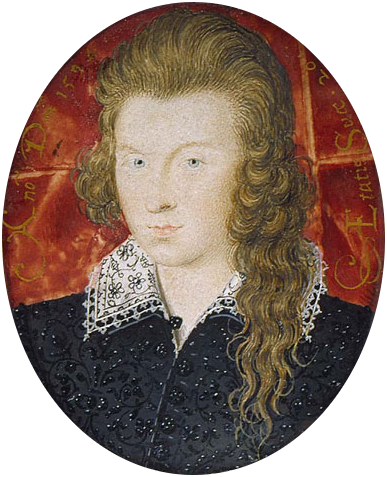
The imagery of this sonnet is shaped by two acoustically similar, gliding words: glass and golden...
If a colour is named in the sonnet, it invariably finds its way into my painting translation...
And since the meaning sonnet is defined by dichotomies: life/death, feminine/masculine, this painting’s has been composed on the strength of a single binary opposition of colours: golden/yellow and blue.
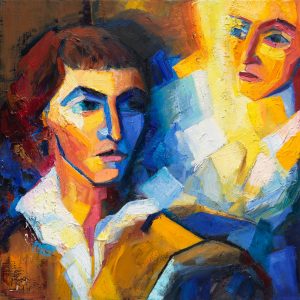
But the heart of this painting is in the imagery of mirroring...
Its structure is loosely based on Edouard Manet’s last unfinished painting, A bar at the Folies-Bergère, with its mysterious figure of a man reflected in the mirror but absent, inviting the spectator to see himself in this reflection.

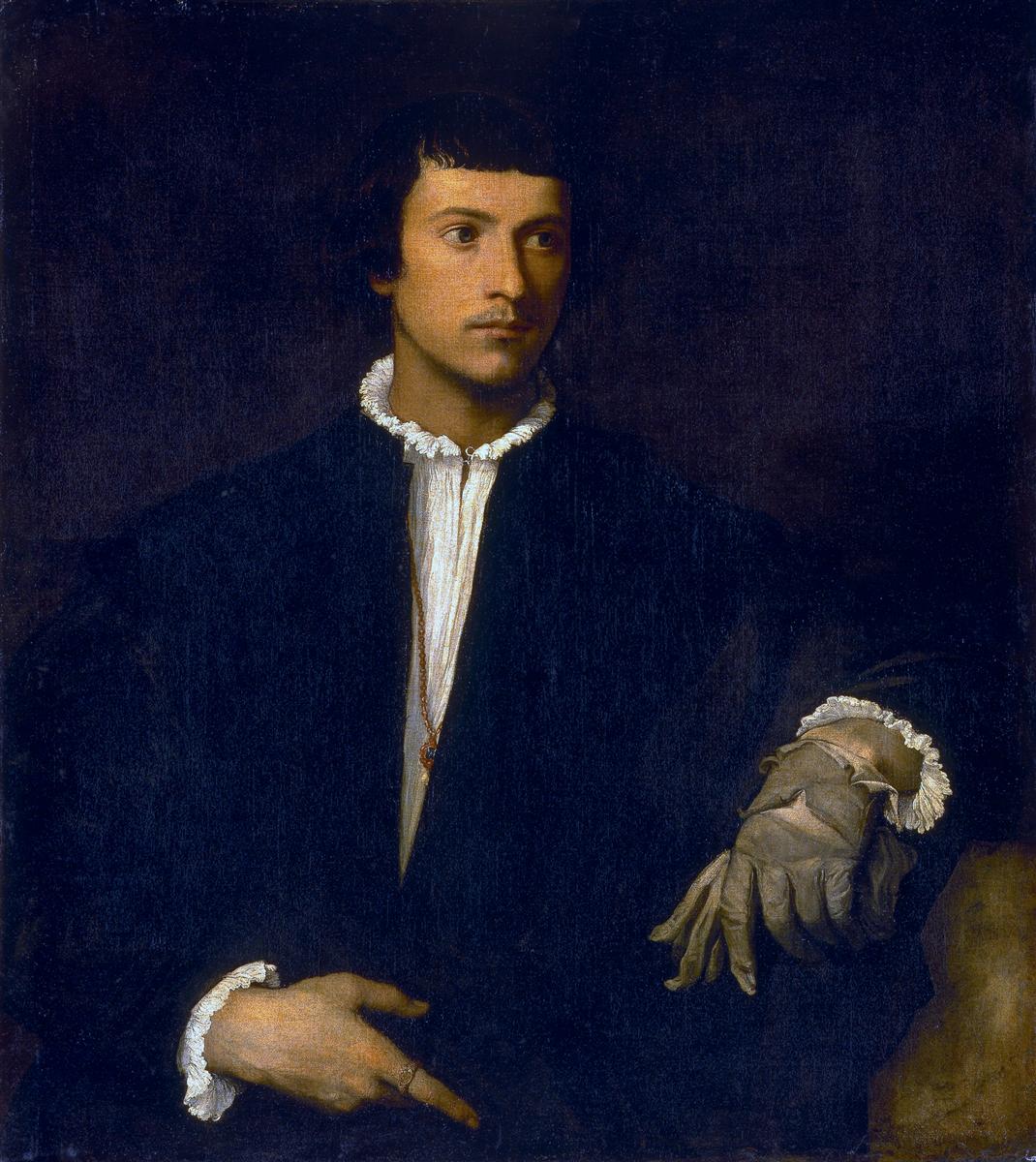
And the image of the young man for this painting came from the Renaissance, from Titian’s young man with a glove.
For the first time, two masterpieces of painting, from two different epochs, fused into one in my painting translation of the sonnet, giving birth to a personal experience of time-transcendence (which, since then, has become an intrinsic part of this work).
This is probably not an accident, because the sonnet itself, with its mirroring through time, defies the concept of linear time…
... two masterpieces of painting, from two different epochs, fused into a painting translation of the sonnet, giving birth to a personal experience of time-transcendence...
Sonnet 4. Profitless Usurer
Unthrifty loveliness, why dost thou spend
Upon thyself thy beauty's legacy?
Nature's bequest gives nothing but doth lend,
And being frank she lends to those are free.
Then, beauteous niggard, why dost thou abuse
The bounteous largess given thee to give?
Profitless usurer, why dost thou use
So great a sum of sums, yet canst not live?
For having traffic with thyself alone,
Thou of thyself thy sweet self dost deceive.
Then how, when nature calls thee to be gone,
What acceptable audit canst thou leave?
Thy unused beauty must be tomb'd with thee,
Which, used, lives th' executor to be.
Conversation: introductory remarks
(April 26, 2020)
Beauty, nature, and the language of profit
Main points and emerging themes
Just like the first sonnet, this one focuses on a separate self, who — in his refusal to participate in life, to pro-create — becomes his own foe, deceives himself of his own sweet self.
But if in the first sonnet, the injunction to procreate had religious overtones, here the self is as it were one-on-one with Nature.
In contrast with the third sonnet (with its abrupt transition between the body of the sonnet and its couplet), here we find two “lexical ties”, two words present both in the body and in the couplet:
- One tie is the world beauty (beauteous),
- the other, all variations and forms of the word use.
There is also a third, less straightforward, but more intriguing tie:
love (as the root in loveliness), live, leave (repeated as live in the couplet).
It is not a lexical tie, strictly speaking: these are different words, but they are connected both phonetically and — at least in the context of this sonnet, semantically (because leaving something after yourself is conceptualised as living beyond the confines of yourself).
So live — love — leave appear almost like different forms of the same verb.
Two languages
The two main lexical ties represent two layers of language present in the sonnet.
One is the language of love, beauty, nature. The other, the language of financial, socio-economic transactions: legacy, lending, use, profit, usury, audit, executor…
And it is in this language of financial transactions that the whole relationship between Self and Nature is conceptualised.
This tendency to conceptualise everything in terms of “banking”, in the “language of money”, has grown more ubiquitous since Shakespeare’s time...
So one question this sonnet raises for us is: does it really work?
Is it a good framework to think about our relationship with Nature, and with one another?
In the context of this question, notice these clear semantic waves of the sonnet:
Three questions, following the exact same form
[Adjective + Noun], why dost thou…
Except in this [Adjective + Noun] phrase, the higher language is first present as a noun, loveliness (pointing to the essence), then it moves to the adjective, beauteous
— and then, in the third variation on this theme, it disappears completely, and only the banking language remains: profitless usurer.
Like in music, a theme repeats itself and crystallises itself in the process.
“Nature’s bequest gives nothing but doth lend, and being frank, she gives to those are free”
These two lines are, for me, the main "entrance" to the sonnet...
That's where it resonates and asks questions for us to answer...
Is it true that Nature only lends...
.... but never gives, freely and unconditionally?
What does it mean, then, that she is “frank” and we are “free”?
In Shakespeare’s language, both words can be understood as “generous” — she is generous and gives to those who are generous, too…
but if it is lending (with the expectation of “profit”), then is it generosity? If we are expected to “pay back”, is it freedom?
This experience of freedom, which shapes and defines human condition — is it really an illusion, then?
At the time, this experience was just emerging, because the society was growing somewhat more liberal, less constraining, with people having more choices about what to do with their lives, or who to marry (or as the case may be, not to marry)…
Since then, there has been a steady increase in these “external” degrees of freedom (unless, of course, right now, when we are limited by the pandemic and our liberties are severely restricted).
But what about this inner experience of freedom?
There is, by now, extensive research into the illusory nature of “free will”: when we experience making a free choice, the decision has been, in truth, already made for some time, without one’s conscious awareness.
By whom?
These questions feel particularly poignant now, as our “external” liberties are, out of a sudden, severely restricted… by whom?
By the government — or by Nature herself, knocking at our collective doors to collect the debt?
And what about our inner experience of freedom — is it really affected by these new constraints?
Another question this sonnet poses, for me, comes from these two lines: why doest thou use so great a sum of sums, yet canst not live?
In the sonnet, this question is addressed to someone who has been given a lot — in beauty, and in wealth — and yet fails to truly live, to be fully alive.
What does it mean: canst not live?
The question hints at the fact that simply being "medially" alive and being fully alive, fully participating in the flow of life — that these are two different states of being entirely.
And this is the experience of this painting: how it is to inhabit the self that fails to be truly alive because it disconnects herself from her environment. The desperation that comes from not being fully connected to life.
Profitless usurer, why doest thou use
so great a sum of sums, yet canst not live?
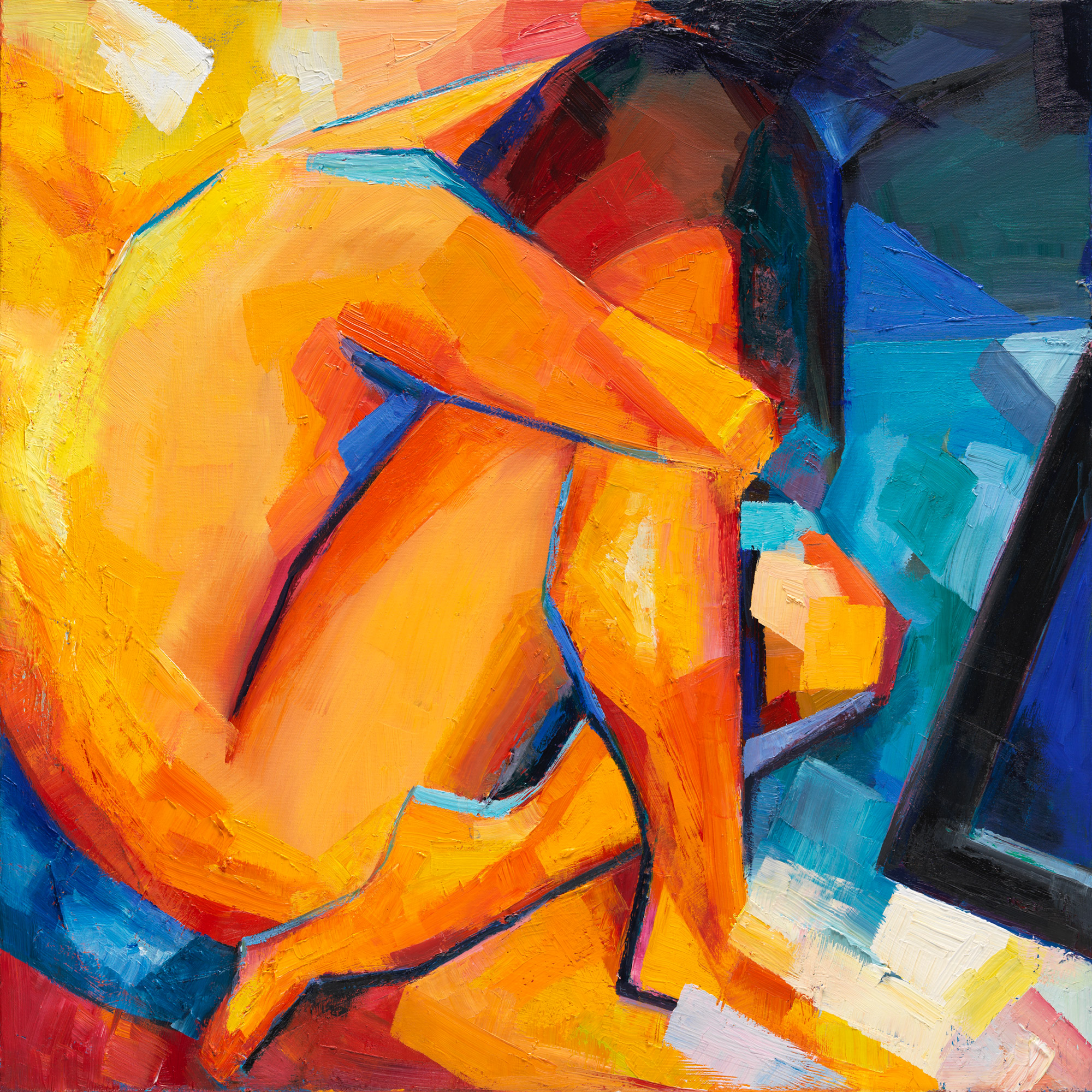
Sonnets 5 & 6
We combined the contemplation of these sonnets within one conversation.
Sonnet 5. Flowers distilled
Those hours, that with gentle work did frame
The lovely gaze where every eye doth dwell,
Will play the tyrants to the very same
And that unfair which fairly doth excel:
For never-resting time leads summer on
To hideous winter and confounds him there;
Sap check'd with frost and lusty leaves quite gone,
Beauty o'ersnow'd and bareness every where:
Then, were not summer's distillation left,
A liquid prisoner pent in walls of glass,
Beauty's effect with beauty were bereft,
Nor it nor no remembrance what it was:
But flowers distilled though they with winter meet,
Leese but their show; their substance still lives sweet.
Sonnet 6. Leaving thee living
Then let not winter's ragged hand deface
In thee thy summer, ere thou be distill'd:
Make sweet some vial; treasure thou some place
With beauty's treasure, ere it be self-kill'd.
That use is not forbidden usury,
Which happies those that pay the willing loan;
That's for thyself to breed another thee,
Or ten times happier, be it ten for one;
Ten times thyself were happier than thou art,
If ten of thine ten times refigured thee:
Then what could death do, if thou shouldst depart,
Leaving thee living in posterity?
Be not self-will'd, for thou art much too fair,
To be death's conquest and make worms thine heir.
Conversation: introductory remarks
(May 3, 2020)
Sonnets 5 & 6: Shattering the rhythms of time
Main points and emerging themes
Sonnets five and six form a kind of diptych, almost a single sonnet, even though each stands on its own (and my paintings of them, too, form a diptych within the larger nine-paintings “collage”).
Never-resting time is at the heart of both sonnets, and together they shatter our (“human”) relationship with time, and how we think about its natural rhythms and seasons in relation to the human life.
Sonnet 5 initiates several themes and motives that will continue to play out throughout the sequence…
First of all, notice how the sonnet says as it were the same thing in two different ways, “rational” and “emotional”, abstract and concrete.
He starts, in the first stanza, so calmly, wisely, rationally — slowly, objectively, just describing things as they are.
Those hours, that with gentle work did frame
The lovely gaze where every eye doth dwell,
Will play the tyrants to the very same
And that unfair which fairly doth excel…
And then, in the second stanza, the tone changes completely — it’s not abstract and objective, but very concrete, visualised, tangible; and the rhythm, the music of the sonnet changes as well:
For never-resting time leads summer on
To hideous winter and confounds him there;
Sap check'd with frost and lusty leaves quite gone,
Beauty o'ersnow'd and bareness every where:
Almost like two different people speaking…
Time of the second stanza is the time of natural life, natural flow of seasons (and my painting jumped onto this opportunity to just paint flowers from life)… but not quite, because in the natural order of things, winter is not final — spring is just around the corner, isn’t it?
And flowers will blossom again…
But the sonnet blocks this direction of thought, this thought pattern… because there is no spring in the space of the sonnet, and the only way to save the essence of a flower is distillation.
There is no natural rhythm, in which we expect flowers to re-emerge in the spring… we see the story from the point of view of an individual, unique flower-being.
And for this being, winter is final.
The only way it can live on is as this liquid prisoner pent in walls of glass.
The metaphor is probably about perfume, but in the context of the sonnets — where the only alternative to “natural” immortality through procreation is art — isn’t it about poetry? Its fluid language pent in glassy confines of the sonnet form, to preserve the essence (= substance) of beauty?
So my painting (where bareness everywhere is transmuted into the loss of colour) — this painting is not “about” flowers, but flowers painted, or flowers reflected. It is not a painting of flowers, but a painting of flowers distilled in painting (just like they are distilled in poetry).
The simultaneous presence of summer and winter, colour and bareness — this comes naturally to painting (which can bring together all time), but notice how Shakespeare does it in the sonnet: the first stanza flows through all grammatical tenses — past, present, future.
And in the second stanza, where the tension rises: it is all in the present, all time brought into a single moment: it happens now, and it happens always.
And notice how this sonnet is completely impersonal, unlike most of them (being love poems, they are filled to the brim with personal pronouns). Here, there is no “I”, no “thou”, not even “them” — and therefore, no imperatives, no advice or injunctions.
Instead, the theme continues into the next sonnet, which starts where this one leaves us: is this how things are, then let not winter’s ragged hand deface in thee thy summer…
Although the metaphor of procreation-as-usury returns in this sonnet (we’ve seen it in Sonnet 4 already), but in a completely different way: the growth of money in usury is, here, like a natural growth of plants — happy-happy-happier, ten times ten times ten (thousand percent “return”!).
If the flower of Sonnet 5 is like a human in its uniqueness, and in utmost finality of its death — then here, the young man is like a flower, who doesn’t care about the transience of his life because he is going to be replicated again and again and again, thousand times.
And then, we come to this very important word: leaving… what does it mean here?
Usually, to understand a word (in a sentence) is to figure out which of its multiple meanings is intended in the given context: to disambiguate the word (we do it all the time, quite unconsciously).
But here, it’s quite different: all meanings of leaving are relevant, all of them actualised, all are present:
It is leaving = departing (you depart = you leave), and but then there is a paradox: you depart (leave) and yet you stay (live), which is, of course, the whole point.
But then, death itself may be the subject of leaving here: what could death do but leave thee living?
And then, the idea of leaves, the greenery, is still alive in our minds from the flower metaphor — and, according to Stephen Booth, it is also reinforced by all the usury/percentages metaphors, because “leaves” were used at the time in arithmetic notations.
So in this painting (Sonnet 6), the loss of colour (bareness everywhere) of Sonnet 5 is replaced by greenery, a suggestion of leaves in the fusion of blue and yellow.
Our lives unfold in the context of time defined by natural rhythms — years, seasons, months, days. But a human life exists as a vector, a straight line, from birth to death, a unique (and unrepeatable) story — because this is how we reconstruct the past, and imagine the future, as a story, a linear moment-to-moment unfolding.
The human mind is capable of reaching both into the past and into the future — we have this time-travelling machine inside of our heads…
And this ability is thought of in our culture into two diametrically opposed ways: as a curse that always takes us out of the present moment, preventing us from being fully present to its uniqueness and beauty.
And as a blessing, which allows you to learn from the past, to foresee the future and take care of your “future self” — this is what Shakespeare asks the young man to do, doesn’t he? So what is it? A curse or a blessing?
Are we supposed to use our time-travelling abilities, or stay within the present moment?
But another way to think about this ability is that it doesn’t need to take us away from the present moment, but allows us to bring the past and the future into the present — and then, the present stops being a transient moment of never-resting time … and becomes eternity.
In a sense, that’s what we are doing now, bringing Shakespeare into the present of our awareness…
I think these sonnets also invite us to think of different ways in which the past flows to the future through present — in the organic flow of nature, and also in preserved “distillations”. We are biological descendants of those who came before us, but our present is also filled with a multitude of distillations — the heights of human spirit.
Contemplating these sonnets can shake up our relationship with time, it interrupts unconscious thought patterns and constructs, and allows us to perceive time in a completely new way.
Sonnet 7. Golden pilgrimage
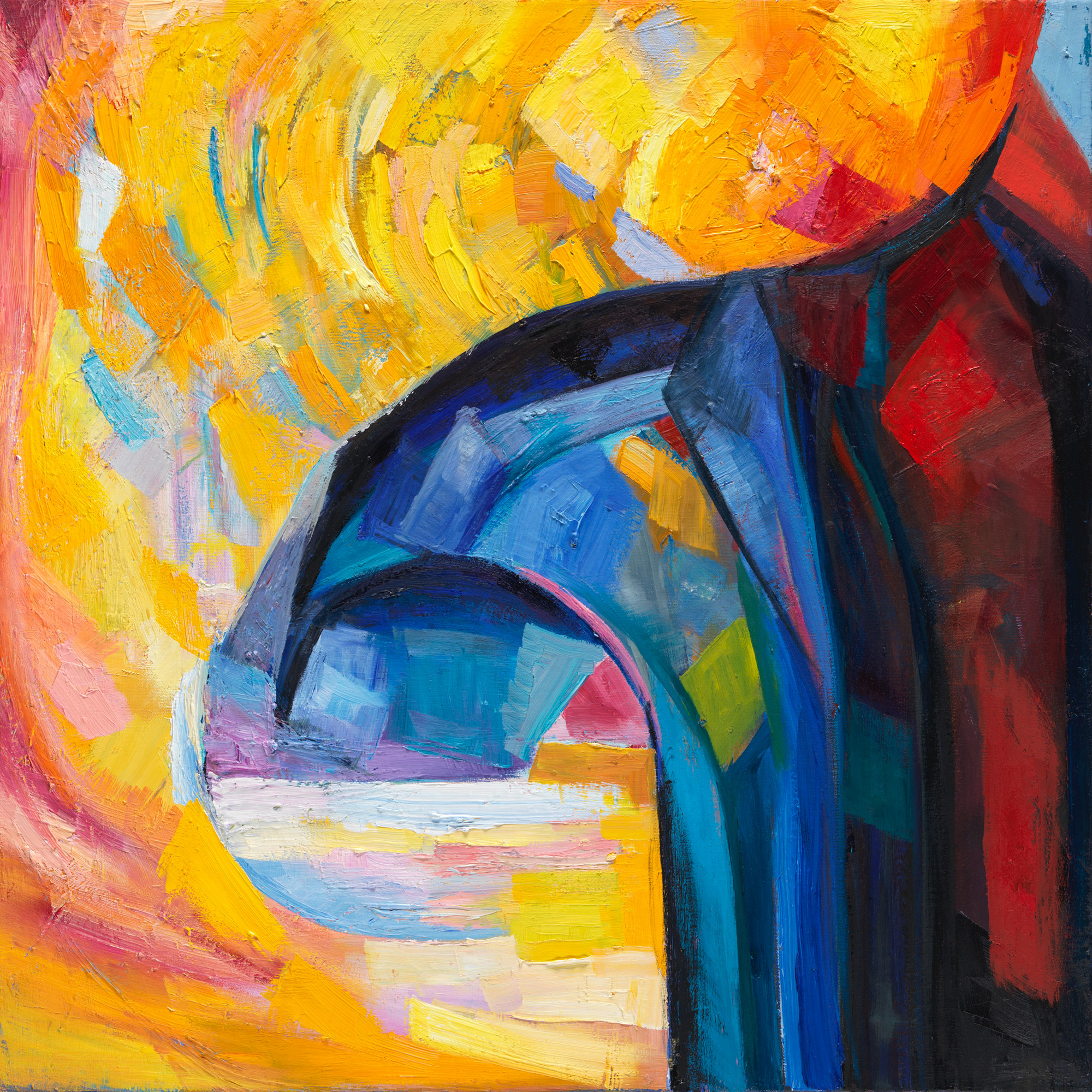
Lo! in the orient when the gracious light
Lifts up his burning head, each under eye
Doth homage to his new-appearing sight,
Serving with looks his sacred majesty;
And having climb'd the steep-up heavenly hill,
Resembling strong youth in his middle age,
yet mortal looks adore his beauty still,
Attending on his golden pilgrimage;
But when from highmost pitch, with weary car,
Like feeble age, he reeleth from the day,
The eyes, 'fore duteous, now converted are
From his low tract and look another way.
So thou, thyself out-going in thy noon,
Unlook'd on diest, unless thou get a son.
Conversation: introductory remarks
(May 10, 2020)
The golden pilgrimage
Main points and emerging themes
Sonnet 8. Beeing many, seeming one
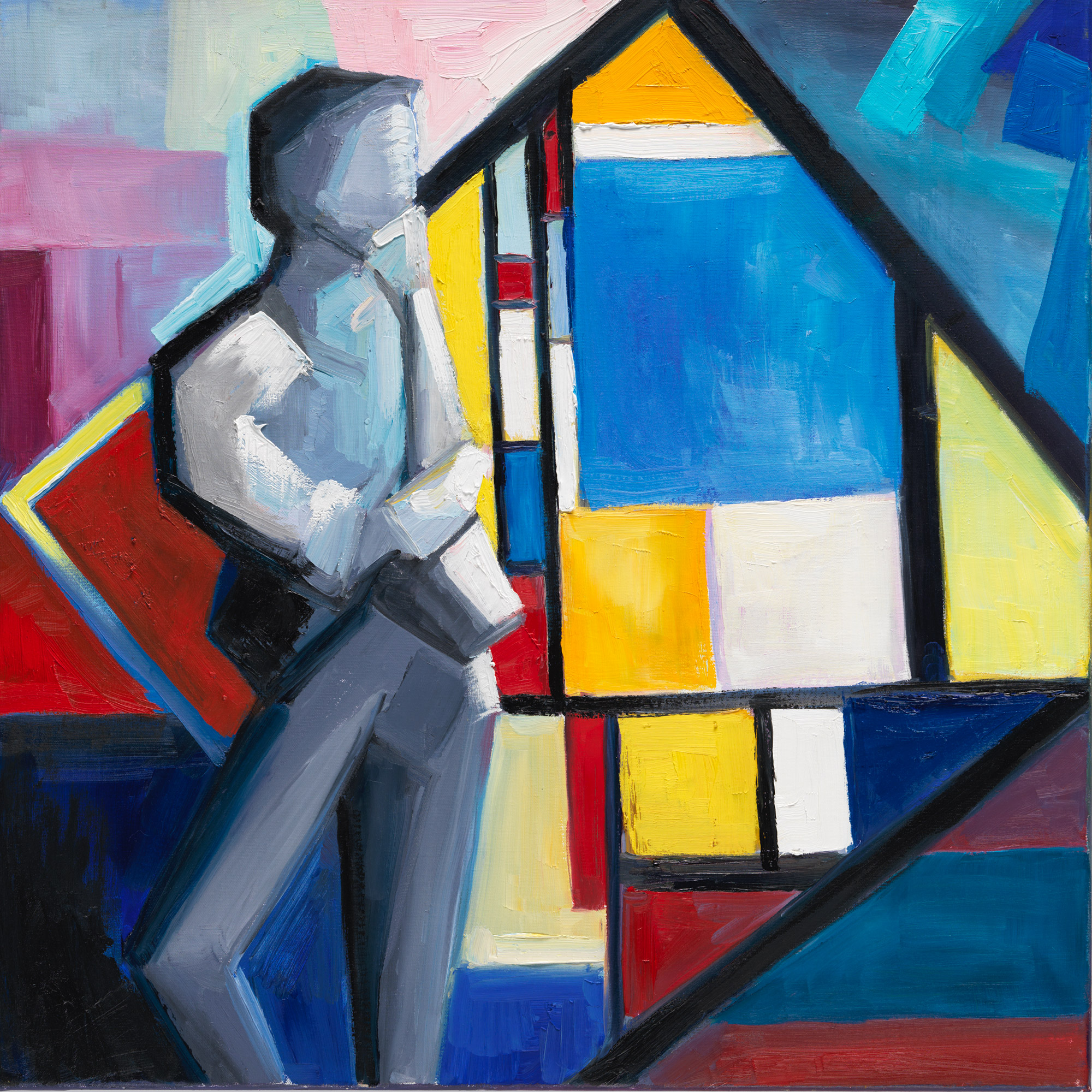
Music to hear, why hear'st thou music sadly?
Sweets with sweets war not, joy delights in joy.
Why lovest thou that which thou receivest not gladly,
Or else receivest with pleasure thine annoy?
If the true concord of well-tuned sounds,
By unions married, do offend thine ear,
They do but sweetly chide thee, who confounds
In singleness the parts that thou shouldst bear.
Mark how one string, sweet husband to another,
Strikes each in each by mutual ordering,
Resembling sire and child and happy mother
Who all in one, one pleasing note do sing:
Whose speechless song, being many, seeming one,
Sings this to thee: 'thou single wilt prove none.'
Conversation: Introductory remarks
(May 17, 2020)
Music to hear
Main points and emerging themes
On its surface, this sonnet is an attempt to develop a somewhat preposterous argument: the young man doesn’t enjoy music, because music is a kind of marriage, and he is against marriage…
But let us try and go deeper…
First of all, notice the rhythmical variations of the first stanza: each line consists, semantically, of two parts — and each of these components deviates from the basic iambic rhythm of the sonnet in its own way: an outburst of rhythmical variation, as thought the sonnet were emulating music.
And notice this special paradoxical key word, which ties the body of the sonnet and its couplet: it is a complicated and non-conventional one: sing/single.
These words, phonetically similar, but — in the context of this sonnet — semantically opposed, as thought two sides of a coin. And this being Shakespeare, we can be quite sure in his delight in creating, fleetingly, this special, self-contradictory, paradoxical word.
To carry his argument through the whole sonnet, Shakespeare “divides” music into parts, into its different aspects: first sounds, then medium (“strings”), then content (“song”). And he repeats the same idea for all these parts:
If this harmony, this metaphorical marriage, offends you, maybe you should look at yourself…
While the association between music and marriage may seem strange at first, it pushes us to towards the platonic idea of harmony…
But this division of an indivisible whole into parts, this honest attempt to analyse into the unknowable — what it brought in into the field of this sonnet in my painting process, was the work of Piet Mondrian, his dividing yet harmonising abstract paintings…
The harmony that arises out of disparate parts, this is the essence of the music Shakespeare stresses here… and words pointing to this harmony are repeated throughout this sonnet. This possibility of being one and many at the same time. And it is also, perhaps, a tension inherent in the sonnet form: divided, structured, yet unified.
Can it be that this whole sonnet is not just about a young man’s resistance to marriage, but rather about the mind’s frustration with the mystery of art? Art is not something mind can analyse or fully comprehend (and not for the lack of trying)…
There is a scene in one of Shakespeare’s plays, “Much ado about nothing”, which “unboxes” this sonnet: a young man, railing against marriage and frustrated with a song. Here is the video of this scene, from Kenneth Branagh’s movie. he key sentence of this scene, for me, is the first one:
Is it not strange that sheep’s guts should hail souls out of men’s bodies?
This is the question, this is the mind’s frustration…
What is it that art is doing here?
It remains beyond the mind’s understanding, however much neuroscience may study neutrons firing or literary scholars explore the sonnets.… Its effect on our souls, its ability to unite different things without losing their individuality, creating harmony out of different elements…
And this is also one of the key questions of our times: how do we live together without losing our individuality? How can we create harmony in a human society without losing individual freedom… (this is the question the mind cannot answer either, or at least it failed so far).
The figure in my painting, its pose, comes from this scene in the movie — so the painting itself unifies, synergistically, these seemingly disparate parts: the sonnet, the play, the movie, Piet Mondrian’s work…
Sonnet 9. The world will be thy widow
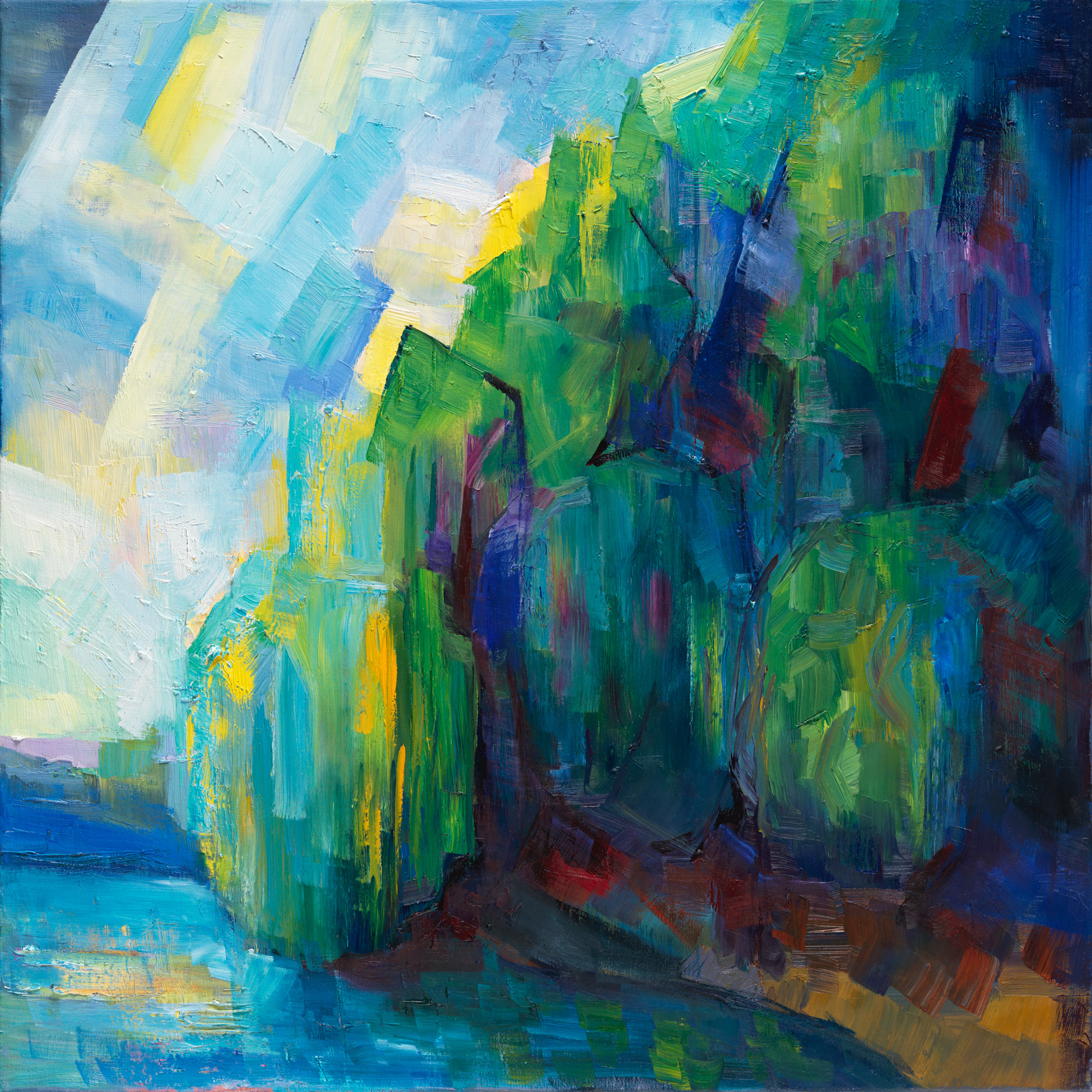
Is it for fear to wet a widow's eye
That thou consumest thyself in single life?
Ah! if thou issueless shalt hap to die,
The world will wail thee, like a makeless wife;
The world will be thy widow and still weep
That thou no form of thee hast left behind,
When every private widow well may keep
By children's eyes her husband's shape in mind.
Look what an unthrift in the world doth spend
Shifts but his place, for still the world enjoys it;
But beauty's waste hath in the world an end,
And kept unused, the user so destroys it.
No love toward others in that bosom sits
That on himself such murderous shame commits.
